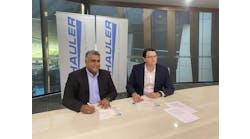"AADvance gave us the scalability we wanted, so it wasn't cost prohibitive for a small SIS like ours." PPG’s Matthew Kinsinger shared the development process for a relatively small safety instrumented system at its Barberton, Ohio, plant.
Good things come in small packages and apparently in small safety instrumented systems (SIS), too.For example, PPG Industries recently investigated how to reduce risk in the chloroformates unit at its specialty coatings and materials plant in Barberton, Ohio. The larger plant opened in 1899, while the chloroformates unit has been operating for more than 45 years, and progressed from manual control to pneumatics and relays, and onward to its present PLCs, interlocks. Chloroformates are a key raw material in the production of CR39, an optical lens material used in the manufacture of eyeglasses.
Following its evaluation, PPG decided to adopt an AADvance safety instrumented system from Rockwell Automation because it could provide the risk mitigation needed at reasonable cost—even though the chloroformates unit only has 50 I/O, making it smaller than most SIS installations. "This is a toxic application. We create phosgene, even though we immediately consume what we make,” said Matthew Kinsinger, senior process control engineer, Barberton, PPG Industries.
Kinsinger presented "PPG minimizes risk and matches performance needs by implementing an SIS" at this week’s Rockwell Automation Process Solutions Users Group meeting in the run-up to Automation Fair in Philadelphia.
Brief history of safety
Because it falls under the jurisdiction of the U.S. Occupational Safety & Health Administration's (OSHA) 29CFR1910.119 process safety management (PSM) rules, the chloroformates unit has undergone periodic process hazards analyses (PHA) since the early 1990s, including revalidations every five years. More recently, the PSM group at PPG wanted to move to using layers of protection analysis (LOPA) to evaluate risk, quantify and validate the effectiveness of safeguards identified in the PHA.
"We wanted to use the LOPA to review and define all the items that we considered to be interlocks, and analyze the gaps in our system," explained Kinsinger. "We used our existing interlock process management as a starting point, and worked backwards from there to identify all related scenarios and equipment to be concerned about. Next, we took our PHA data, and evaluated all scenarios involving high-severity rankings regardless of likelihood. Finally, we applied LOPA results in more detailed risk rankings, which can sometimes lead to fewer but more appropriate safeguards.
"By quantifying the effectiveness of the safeguards identified in the PHA, we knew what gaps existed. We also reviewed the effectiveness of the controls, interlocks and additional protections. This resulted in some scenarios where the existing control system, instruments and control devices didn't provide the protection required to meet our acceptable level of risk."
Seeking specifications—and space
Normally, any scenarios requiring a risk reduction factor (RRF) greater than 10 would be moved to or expanded on in an SIS, explained Kinsinger. "SIS control outputs are completely independent of the basic process control system (BPCS), while SIS inputs aren't to be used for control loops in the BPCS."
PPG also contracted with safety engineering consulting firm Kenexis to facilitate its initial LOPA and develop its safety requirements specifications (SRS) in compliance with the ANSI/ISA84.00.01 standard.
Space was also at a premium. "The chloroformates unit had been operating for about four decades, and because it had already moved from pneumatics to relays to its present Foxboro DCS, it was out of space. We had to find another place for our safety solution."
Kinsinger said that PPG eventually decided to build a small addition to its existing control room, which consisted of an 8 x 8-foot space with a steel roof. It cost $5,000-$6,000, and provided enough space for the unit's new safety cabinet.
PPG also decided to implement Rockwell Automation AADvance safety system because it provided the flexibility and scalability the chloroformates unit required, used its own programming software, and allowed easy communication from AADvance to the unit's existing ControlLogix control system.
"AADvance gave us the scalability we wanted, so it wasn't cost prohibitive for a small SIS like ours," said Kinsinger. "This wasn't the case with some other products."
Easier execution
In all, PPG's safety upgrade on its chloroformates unit took up the four months available, and consisted of adding seven or eight valves, six transmitters, safety limits on existing valves, the SIS and its cabinet, and several field-installed components.
"We usually run all out for most of the year with just a few two-day outages," said Kinsinger. "This project was going to need some five- or six-day outages, so we saved time by preconfiguring wires, doing a factory acceptance test (FAT) at Rockwell Automation's Houston facility, and performing similar testing onsite."
Pete Skipp, ISA 84/SIS expert and global process safety manager, Rockwell Automation, added that, "PPG demonstrated that applying the quantified risk approach in ANSI/ISA84.00.01 and using qualified resources led to the successful completion of their project. Applying these standards means more upfront work due to the analysis phases and management aspects, and more work to maintain the integrity of the safety loops and safety integrated functions (SIF), but there are usually fewer SIFs and a safer operation in the long run."
The editors of Control are on-site at Automation Fair 2018 to bring you breaking news, innovations and insights from the event. Once the event is over, they will put together a report featuring the top news. Pre-order your copy today.






